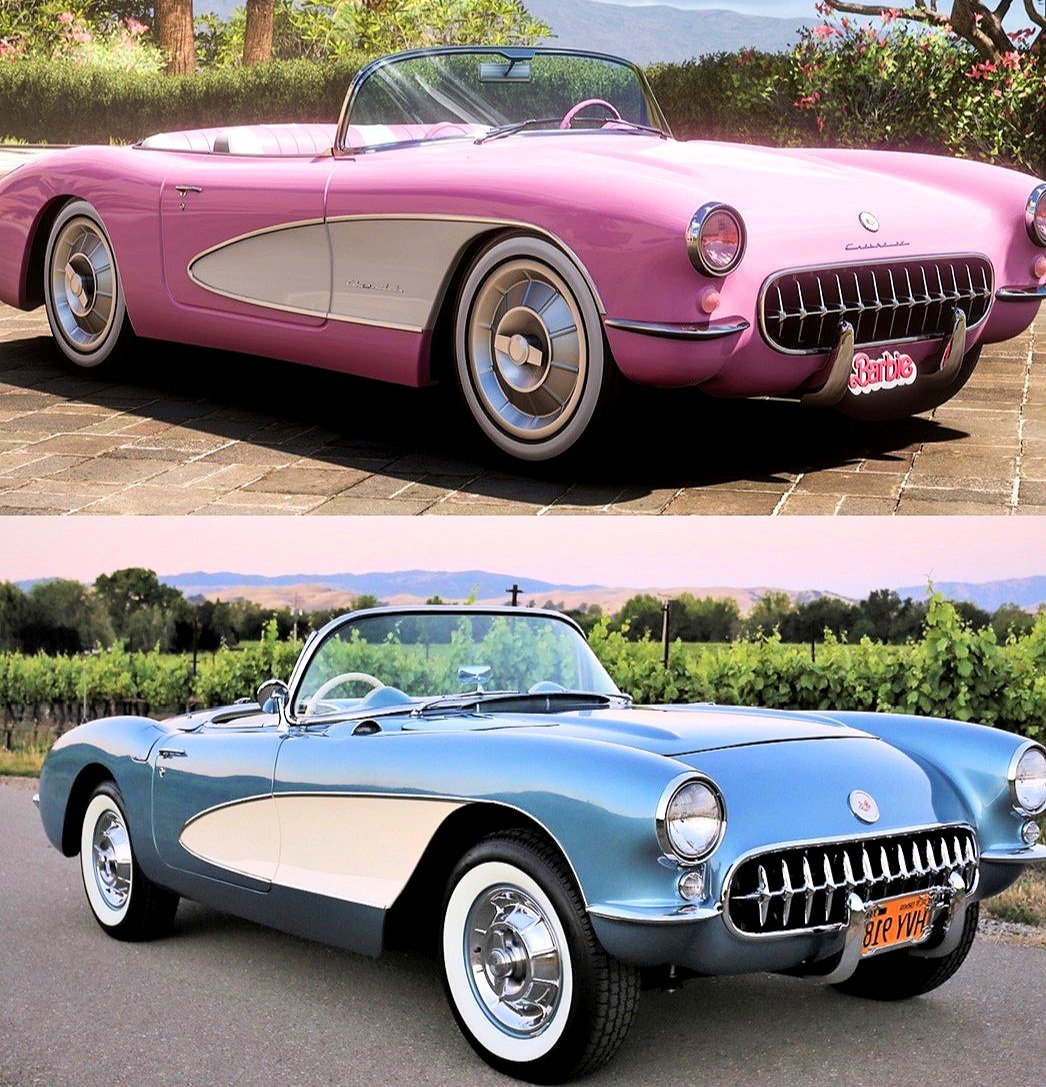Having smashed box office records just months after its release, The Barbie movie is surely an even bigger success than its producers could have imagined. Starring Australia’s stunning Margot Robbie, the success of the Barbie movie has shone the spotlight on the car Barbie drives, a mid 1950s Corvette. Or is it?
It certainly looks like a 1950s Chevrolet Corvette convertible, in Barbie pink no less. And whilst it is based on a ‘C1’ Corvette, it’s actually not a modified ‘vette, but a one-off made for the movie. Smaller than the original, and with a rear seat to accommodate Ken (Ryan Gosling), the movie Corvette has the same gorgeous lines as the original, but not the Chevy small-block V8 soundtrack.
Spot the real Corvette - Barbie’s on top, and below is a two-tone 1957 original (there are only minor differences between a ‘56 and a ‘57 Corvette)
No stock Corvette has ever come with rear seats, but in a Barbie world things are different. And why a Corvette, when Barbie has been associated with more exotic cars from the likes of Porsche and Ferrari over the decades? Not only that, but the first toy car a child could buy for their Barbie doll, in 1963, was an Austin-Healey.
Visit the Austin-Healey gallery
We can only surmise that Barbie, being an American creation from the late 1950s, should be driving the most toy-like American car of the 1950s. Corvettes were, like so many toys, made from fiberglass. They were small, light, and almost toy-like in real life, especially compared to the behemoths Detroit was churning out at the time. So perhaps it does seem appropriate for Barbie to drive a Corvette, even if it is a smaller, electric version.
Barbie’s pint-sized Corvette has a back seat where Ken (Ryan Gosling) stows away.
Corvette went to dual-quad headlights from ‘58, so the Barbie car looks to be 4/5 scale of the 1956/57 model. Even experts find it hard to tell a ‘56 from a ‘57 (unless the ‘57 has fuel injection - a rare, expensive option not available until that year). Even if Barbie didn’t come into existence until 1959, choosing a ‘56 Corvette isn’t a bad choice - it’s arguably the prettiest of the early V8 Corvettes. Fom 1958 the ‘vette had extra chrome and ornamentation laid on, and while we still love them, they are a little over decorated.
Margot Robbie poses with the genuine article - a 1956/7 Corvette painted in the same Barbie pink as the smaller, electric version used in the movie.
As for the real Corvette, the iconic first-generation C1 sports car was first released in late 1953 (as a 1954 model) and it’s fair to say it wasn’t a great success. Available only with a staid ‘Blue Flame’ six and two-speed Powerglide auto transmission – the first Corvettes were hardly true sports cars, despite the racey looks. When Ford released a two-seater in 1955, the famous Thunderbird, it was immediately offered with V8 power. Chevrolet introduced their first new V8 that same year, giving Corvette the powerplant it so badly needed. Not only that, it could be optioned with a four-speed stick shift. The performance Corvette was born.
In 1957 Chevrolet offered a fuel-injected version of the 265 small block V8, and made it available on the Corvette. When ordered with the expensive ‘fuelie’ option, Corvette became one of the fastest and most powerful sports cars available anywhere in the world, and at a fraction of the cost of Ferrari’s and Maserati’s.
‘In looks, the ‘57 Corvette magnificently combines the classic with the new.’
In time, the hottest V8 versions of the C1 Corvette became not only performance legends but cultural icons named in hit songs by the Beachboys and Jan & Dean, driven by a young Bruce Springsteen and other celebrities, they dominated racetracks across America and started the legend.
Now in 2023, the C1 Corvette has found new fame as the preferred wheels of Margot Robbie as Barbie, in the movie that will quite possibly become the highest-grossing film of all time.
Check out our article on the Top Ten TV Cars
C1 Corvettes are already worth a small fortune, what are the chances a few are being painted in Barbie pink at this very moment, in the hope of selling to a wealthy fan of the Barbie movie? I’d prefer one in virtually any color but pink, but hey - each to their own.
For those wanting a pink Corvette but can’t afford the real thing, you can console yourself with the toy version by way of Mattel’s Hot Wheels - it's remote control.
The Barbie Movie is released on Global streaming platforms this month
Barbie Movie images credit: © 2023 WARNER BROS. ENT. ALL RIGHTS RESERVED
Check out our Articles for more great stories on famous cars
About the author
Raph Tripp is a movie buff and passionate classic car enthusiast, writer, and founder of TunnelRam.net. If you wish to publish this article in part or in whole, please credit Raph Tripp and tunnelram.net . This is an original Tunnel Ram production ©2023 Tunnel Ram. All images remain the property of the original copyright holders.







